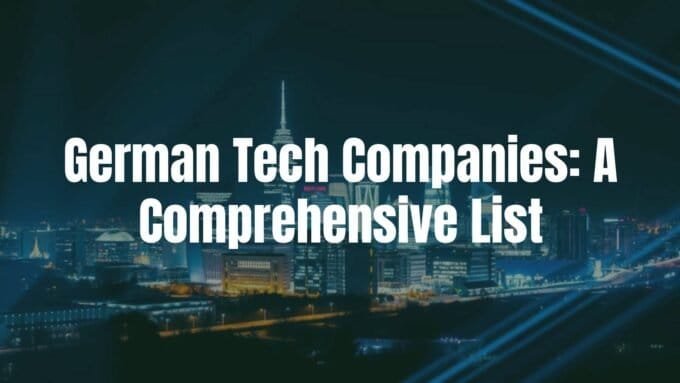Germany, known for its engineering and strong economy, is at a key point in its digital shift. Is it leading or falling behind? The picture is mixed. The country has many strengths and a strong digital market, but some gaps remain and need focused action. This article explores Germany’s digital path: what drives it, how progress is measured, where it is strong, where it struggles, and what chances lie ahead. It also points to the choices that will shape its digital future.
What defines digital transformation in Germany?
Digital transformation in Germany goes beyond buying new tech. It is a broad social and economic change to modernize the country and keep it competitive in a connected, global market. It covers digital public services, the use of advanced tech in industry, and digital tools in daily life. The main aim is to build a place where new ideas grow, work runs smoothly, and people and businesses can use the benefits of a connected future.
Key drivers and goals of digitalization
The push for digitalization comes from several forces. Economically, Germany wants to keep its lead as an industrial nation. The government sees digital tech as a key part of innovation, growth, and national security. It wants “AI made in Germany” to build local strength. It also wants better data use and sharing to open new paths for innovation in many fields.
On the social side, the goal is better quality of life through faster public services and wider digital access. A new Federal Ministry for Digital Affairs and State Modernization, led by a former private-sector leader, shows this focus. Set up under the 2025-2029 coalition agreement, this ministry brings together tasks that were split across six ministries, aiming for a clearer and stronger approach to digitalization.
Government strategies and regulatory framework
Germany’s approach rests on a set of strategic plans and a strong set of rules. The 2025-2029 coalition agreement highlights the digital economy and sets goals like higher investment in AI and quantum computing, better digital public services, and wider digital networks. “Digital Strategy Germany” (August 2022) and the “Strategy for International Digital Policy” are clear plans that back a digital order built on democracy, freedom, prosperity, sustainability, and resilience, placing Germany as a reliable, democratic partner on the global digital stage.
While the EU sets many of the rules for Germany’s digital economy, national laws still play an important role. The Online Access Act, passed in 2017 and updated in 2024, expands digital public services with a goal to make all services for companies fully online by 2029. Another proposal, the NIS2-Umsetzungs- und Cybersicherheitsstärkungsgesetz, brings the EU’s NIS-2 directive into German law, requiring cybersecurity investment and incident reporting for key and important entities.
Impact on society and economic growth
Digital change is already shaping German society and the economy. The digital economy grew steadily to over USD 250 billion in 2024, up from USD 239 billion in 2023, even as other areas slowed. This shows a steady, lively digital market. At the same time, public service digitalization for people and businesses is still below the EU average, showing clear room to improve.
A 2025 study by Uwe Neumann, “Digital transformation, employment change and the adaptation of regions in Germany,” finds that new jobs have largely offset jobs lost to tech over the last decade. Digitalization is more of a job shifter than a job killer, creating new roles and new skill needs. Regions with strong manufacturing and big cities have adapted well, though in different ways, showing varied local effects of digital change.
Key performance indicators for Germany’s digital transformation
Tracking Germany’s progress needs a close look at key performance indicators (KPIs). These measures show where the country is doing well and where it needs more work. From EU-wide scorecards to network stats and public service usage, these signals give a clearer view of Germany’s digital progress.

Digital Economy and Society Index (DESI) scores
The Digital Economy and Society Index (DESI) is a key yardstick for EU countries. A 2024 EU report shows a mixed picture for Germany, especially in public services. Germany is moving forward in many areas, but it scores below the EU average for public services used by people and businesses.
| Area | Germany | EU average |
|---|---|---|
| Public services for citizens | 75.8 | 79.4 |
| Public services for businesses | 78.6 | 85.4 |
The federal government aims to close this gap with major investments and policies like the Online Access Act.
Connectivity and broadband coverage statistics
Connectivity is the base of any digital economy, and Germany has made solid progress. In 2024, fast internet covered 96% of the country. But much of this comes from very high-capacity networks (VHCN) rather than fiber. Fiber to the Premises (FTTP) coverage was 29.8% in 2024, rising but still with space to grow. The 2022 gigabit strategy targets 50% FTTP by 2025 and 100% by 2030, backed by USD 12.6 billion in public funds and an estimated USD 52.6 billion from the private sector.
| Metric | 2024 | Target | Target year |
|---|---|---|---|
| Fast internet coverage | 96% | – | – |
| FTTP coverage | 29.8% | 50% | 2025 |
| FTTP coverage | 29.8% | 100% | 2030 |
An urban-rural speed gap still exists. New rules from June 2025 give fiber and mobile build-outs “preeminent public interest” through 2030 to speed up planning and approvals.
Adoption rates of digital public services
Use of digital public services shows how well the state serves people and companies online. Germany’s usage rates are below the EU average. This suggests a need for better user engagement and easier platforms. The new Federal Ministry for Digital Affairs and State Modernization is tasked with speeding up digital public services and building interoperable platforms to improve them. Plans for a digital ID wallet and citizen accounts aim to raise adoption and simplify how people and businesses deal with the state, easing the load on the economy and improving competitiveness.
Strengths in Germany’s digital transformation journey
Germany’s digital path rests on major strengths. Its long record of innovation, strong industrial base, and active public and private investment all help current progress and set the stage for future gains.
Industry leadership in advanced technology sectors
Germany leads in advanced manufacturing and engineering, and this supports its digital goals. In Industry 4.0, digital tech merges with factory floors to spark new ideas. German firms are early adopters of AI, IoT, and advanced robotics in production, improving efficiency and building smart factories. This deep know-how gives an edge and supports fast use of new digital tools in key sectors.

Beyond manufacturing, U.S.-Germany ties in new tech are strong. The 2024 Joint Statement on Cooperation in Quantum Information Science and Technology (QIST) shows shared plans to deepen quantum work. Vendors and cloud platforms are growing in Germany. IBM opened its first European Quantum Data Center in Ehningen in 2024, with advanced chips and industrial-scale quantum processing, even as debates on digital sovereignty continue.
Wide 5G coverage and rollouts
Connectivity drives a digital economy, and Germany is moving fast on 5G. The new government keeps network build-out high on the agenda. While fiber is a major focus, 5G is just as important. In 2024, Germany agreed with mobile operators to remove Huawei and ZTE from core 5G networks by 2026, showing a strong focus on security.
Germany is also a leader in Open Radio Access Network (Open RAN), which boosts competition and interoperability. Deutsche Telekom, O2 Germany (Telefonica), and Vodafone are rolling out Open RAN, and 1&1 (United Internet) is building a new network based on it. These moves support broad 5G coverage and a strong, competitive, secure network for the long term.
Investments in basic and advanced digital skills
Technology works best with skilled people. Germany is investing in digital skills at all levels to prepare for an AI-driven economy. The updated “Research and Innovation for Technical Sovereignty 2030” (FITS2020) plan, refreshed in January 2025, allocates USD 1.7 billion per year to strengthen digital and industrial tech, while still working with partners abroad.
Still, more effort is needed. The Business Software Alliance (BSA) calls for quick updates to the dual education system and promotes lifelong digital learning, from schools to reskilling. Widening the STEM pipeline and drawing more young people, especially women, into tech are important steps so that skill shortages do not slow progress. By backing continuous learning and education, Germany aims to build a workforce ready to handle and benefit from a changing digital landscape.
Market challenges hindering digital transformation in Germany
Despite strong foundations and active policymaking, Germany faces hurdles. Gaps in infrastructure, a shortage of digital skills, and complex rules can slow progress. These issues need focused, steady work to reach full digital potential.
Infrastructure and connectivity limitations
Even with 96% fast internet coverage, heavy reliance on VHCN instead of fiber is a key limit. FTTP stood at 29.8% in 2024. This gap holds back ultra-fast, long-lasting connections needed for rising data needs, AI, and advanced IoT. The gigabit strategy aims for 100% FTTP by 2030, but the current rollout speed shows the target is tough, even with large funding.

There is also a persistent urban-rural split in speeds. Cities tend to have better access, while many rural areas lag. This gap slows local growth and limits equal access to services and chances. The June 2025 law gives priority to fiber and mobile expansion to speed up planning, but tackling long-standing limits will take steady effort and good execution.
Digital skills gap and workforce readiness
A growing digital skills gap and the need to raise workforce readiness for AI are major challenges. Germany’s education system is strong, but the STEM pipeline is narrow, risking shortages in key tech roles. The BSA warns that without drawing more young people, especially women, into tech, progress could slow.
The dual education model needs a fast update to match rapid tech change. Wide, lifelong digital learning is needed, from basic skills in schools to advanced reskilling. Without enough digital skills, adopting and using new tech will be slower, which could weaken Germany’s position in the global digital race.
Complex regulations and data privacy concerns
Germany strongly values data privacy, backed by GDPR and enforced at state and federal levels. This builds trust but can also create regulatory hurdles that slow fast-paced digital projects. Each state has its own data protection body, which adds oversight and may lead to different views.
The idea of “digital sovereignty,” aimed at reducing reliance on U.S. and Chinese tech, adds more layers. This can open doors but also pose challenges for international firms meeting local content rules, compliance, or facing exclusions. Debates also cover EU efforts like Gaia-X and the EU Cybersecurity Certification Scheme for Cloud Services (EUCS), where participation is still unclear. Balancing privacy and sovereignty with flexible, innovation-friendly rules is hard, and current rules can slow new digital tools and services.
Areas needing improvement for digital success in Germany
Germany has many strengths, but some areas need focused work to reach full and fair digital success. Fixing these gaps will help the country make the most of digital opportunities and keep its edge.
Addressing regional disparities in connectivity
The speed gap between cities and rural areas is a major bottleneck. While overall fast coverage is high, reliance on VHCN instead of fiber means many regions do not get full high-speed benefits. Rural areas are hit hardest, which slows local growth, schooling, and access to key services. The gigabit strategy sets a goal of 100% FTTP by 2030. Speeding up delivery in underserved areas is urgent. This needs strong funding and faster planning and permits. The June 2025 law that treats broadband expansion as being of “preeminent public interest” helps, but more active steps are needed so everyone, no matter where they live, can get reliable, fast internet.
Accelerating digitization of public administration
Even with the new Digital Ministry and the Online Access Act, public administration still trails the EU average, especially for citizen and business services. Many agencies still use paper-based steps and outdated IT, which slows services and wastes resources, as the BSA has pointed out. The long-running “fax machine joke” sadly still fits. A digital-first state brings convenience, resilience, efficiency, and stronger competitiveness. The Digital Ministry should drive clear, visible progress with practical steps and steady improvements: interoperable platforms, a digital ID wallet and citizen accounts, and simpler IT purchasing to make better use of federal IT spending. The aim is to ease the load on the economy and modernize the state.
Improving access to digital education and lifelong learning
The digital skills gap is a serious risk. While Germany invests in high-level skills, access to digital education must widen, and lifelong learning should reach more people. Too few young people, especially women, enter tech careers. Schools, vocational training, and universities need fast updates to make digital skills core. Beyond formal education, easy-to-use reskilling and upskilling programs should help workers adapt to AI-driven jobs. Building a culture of continuous learning and giving people and firms real support will help Germany tap the big benefits of digitalization.
Opportunities for digital growth and innovation
Alongside its challenges, Germany has many chances to grow and innovate. By using its strengths and fixing weak spots, it can strengthen its role as a digital leader. These chances span new tech, joint efforts, and global reach.
Investment in emerging technologies
The government backs new tech as drivers of growth and security, especially AI and quantum computing. Plans include major spending on AI and cloud, with a goal to build “AI made in Germany” under rules that support innovation. The coalition also plans at least one European “AI gigafactory” in Germany, showing a push to become a key AI hub.
In quantum computing, U.S.-Germany work is ahead, backed by the 2024 QIST statement. IBM’s European Quantum Data Center in Ehningen (opened in 2024) adds advanced chips and industrial-scale quantum computing to the local ecosystem. These bets can build new industries, high-value jobs, and long-term tech strength.
Public-private partnerships driving advancement
Working together speeds digital progress, and Germany is building these bridges. The gigabit plan combines USD 12.6 billion in public funds with an estimated USD 52.6 billion from telecoms, showing shared effort on networks. Big projects like this need close cooperation for smart spending and on-time delivery.
Partnerships also matter in cybersecurity and AI. The national cybersecurity plan through 2026 calls for joint work between government and industry. FITS2020 supports local tech while staying open to working with firms abroad. These efforts pool funds, know-how, and risk to produce strong, useful digital solutions for both public and private needs.
International collaboration and export potential
As a high-tech, global economy, Germany sees strong value in working with partners worldwide. The “Strategy for International Digital Policy” (August 2022) is a joint guide for active, coherent work abroad. It presents Germany as a reliable, democratic partner that supports a digital order based on democracy, freedom, prosperity, sustainability, and resilience. It promotes value-based tech partnerships, human-centric and innovation-friendly rules, and active work on global norms and standards.
This outward approach supports sharing knowledge and opens export paths for German digital tools and services. Demand is high for German strengths such as Industry 4.0, advanced manufacturing, and cybersecurity. By deepening these ties, Germany can grow exports, help global digital growth, and strengthen its economy. The Federal Ministry for Digital and Transport leads on international digital policy and is expanding bilateral talks, including with countries in Africa.
Important digital technologies shaping Germany’s future
Germany’s digital future is shaped by a set of advanced technologies that play a big role in changing the economy, society, and public services. From smart automation to secure networks, these tools are key pillars of the strategy.
Artificial intelligence adoption
AI is moving fast from idea to practice across Germany. The government views AI investment as key for security, innovation, growth, and its place in the global economy. A major goal is “AI made in Germany” through innovation-friendly rules. The coalition plans at least one European “AI gigafactory” in Germany to back this goal.

The impact is clear. Germany’s AI market for building and running AI platforms grew by 43% in 2024 to USD 2.5 billion. Bitkom reports that 42% of German industrial firms already use AI in production, and another 35% plan to adopt it. This wide use supports smarter manufacturing, higher efficiency, and new ideas across sectors. The EU’s AI Act sets common, responsible rules for AI in Germany.
Cloud computing and data centers
Cloud computing is now a basic part of Germany’s digital setup, used widely by businesses. The cloud market is set to grow 17% in 2025 to USD 21.5 billion. A 2025 Bitkom report says 90% of German companies use cloud services, with most others planning to join. Common uses include bookkeeping, finance, office software, email, and storage.
Also, 77% of firms use or want to use cloud-based AI services, showing how cloud and AI fit together. While companies prefer German cloud providers, 65% will choose them only if they are as good as U.S. and other rivals. Many firms (41%) use multi-cloud setups to improve resilience and avoid outages. Nearly all companies rank IT security, data protection, and compliance as must-haves, alongside performance, stability, and encryption.
Cybersecurity advancements
Cybersecurity is a top concern and a fast-growing market. Seven in ten German companies feel strongly threatened by attacks. More than 80% were hit in 2024, with damages reaching USD 312 billion-up almost 30% from 2023. This shows the need for strong protection.
Security software revenues rose 11% in 2024 to USD 5.5 billion. The national cybersecurity policy, updated in 2021 and running through 2026, focuses on protecting people and society, joint work between government and industry, and a solid cybersecurity setup across all levels of government. The NIS2-Umsetzungs- und Cybersicherheitsstärkungsgesetz will require security investments and incident reporting for key entities, boosting the country’s defense.
Internet of Things (IoT) integration
IoT is spreading across German industry and cities, building on a strong manufacturing base and Industry 4.0. Connected sensors and devices share data to improve processes. In factories, IoT supports real-time machine data, predictive maintenance, and better supply chains, leading to smarter, more flexible production. Cities use IoT for infrastructure, traffic, energy use, and public safety.
5G and better networks make IoT scale possible. Low latency and high bandwidth are key for real-time needs like autonomous vehicles and remote care. As Germany expands networks, IoT can drive big gains in efficiency and innovation.
5G and advanced connectivity infrastructure
Rolling out 5G and improving networks is central to Germany’s digital plans. While 96% of the country has fast internet, the focus is moving to fiber and reliable 5G to handle new tech demands. The gigabit strategy targets 100% FTTP by 2030, and the June 2025 law speeds fiber and mobile build-outs.
On mobile, Germany leads in Open RAN, which increases competition and interoperability. Deutsche Telekom, O2 Germany (Telefonica), and Vodafone are deploying Open RAN, and 1&1 is building a new network on it. This boosts flexibility and innovation and helps address security risks, supported by the 2024 plan to remove Huawei and ZTE from core 5G by 2026. These network gains power AI, IoT, smart cities, and advanced industry, helping Germany stay ahead.
Which industry sectors are transforming fastest in Germany?
Digital change moves at different speeds across sectors. Some move fast due to innovation or market pressure. Others are still working through hard parts of tech adoption. Looking at leaders shows where digital growth and investment are most active.
Manufacturing and Industry 4.0
Manufacturing leads Germany’s digital change, thanks to its strong base and the well-known idea of Industry 4.0. The sector is adopting AI, IoT, and robotics to build smart factories, optimize production, and improve supply chains. Bitkom says 42% of industrial firms already use AI in production, with 35% planning to add it. These changes turn traditional manufacturing into automated, data-driven, connected systems. Focus areas include predictive maintenance, real-time quality checks, and custom production, which raise productivity and competitiveness. Germany’s engineering strength makes this sector a natural leader.
Healthcare digitalization
Healthcare is changing fast to improve patient care, data handling, and advanced medical tools. Efforts include electronic health records, telemedicine, and AI-supported diagnosis. Data privacy rules are strict in healthcare, but the benefits are clear: faster admin, personalized care, and remote monitoring. COVID-19 sped up digital health work, showing the need for reliable, accessible services. Investment in health tech startups and secure digital infrastructure is growing.
Retail and e-commerce growth
Retail has changed quickly, driven by e-commerce. More shoppers buy online, pushing retailers to build strong online platforms, better logistics, and personalized digital experiences. Stores are also going digital with modern payments, smart inventory, and data analytics. A 2024 Deutsche Bundesbank report found 51% of payments were still cash (high compared to other big economies), but card use is growing, showing a steady shift to digital payments. Competition from global e-commerce firms pushes local players to innovate.
Financial services and fintech innovation
Finance is moving fast with a growing fintech scene. Banks invest in digital platforms, mobile apps, and AI-driven service. Fintech firms bring new ideas in payments, lending, and investing. Government plans for a Digital Euro or Digital Wallet show a push to modernize payments. Security and privacy are central due to sensitive data, and strong EU rules, including GDPR, provide a safe setting. The mix of established strength and agile fintech is reshaping the sector.
Government and public service digitalization
Public services are changing too, though slower than some sectors. The Digital Ministry and Online Access Act show real commitment. The aim is better digital public administration with easier, faster services for people and businesses. Key steps include interoperable platforms, digital ID, and simpler processes. Even though Germany trails the EU average here, the government is investing to catch up, cut red tape, speed services, and modernize the state for higher competitiveness and better citizen experience.
Digital rights and principles for Germany’s transformation
At the core of Germany’s digital push is a strong commitment to ethics and basic rights. The country seeks a human-centered, safe, and inclusive digital future, supported by strong data protection, wide access, and responsible use of AI.
Commitments to data protection and privacy
Data protection and privacy are key pillars of policy in Germany. Oversight exists at both state and federal levels, with state data protection bodies and a Federal Commissioner covering federal public authorities and telecoms/post. GDPR sets the global benchmark, and Germany helped shape it.
Strict privacy rules mean companies must follow tight standards, which can be complex but build high user trust. This is clear in cloud use: firms rate IT security, data protection, and compliance as must-haves. A strong focus on privacy helps people keep control of their data and supports privacy by design in digital services.
Digital inclusion and accessibility
Success means no one is left behind. Germany aims to close the digital gap and give equal access to digital tools and chances. This includes fixing the city-rural speed gap with the gigabit strategy and laws that speed broadband build-outs.
Beyond networks, inclusion means public services must be easy to use for everyone, no matter their digital skills or abilities. The Digital Ministry’s push for a digital ID wallet and citizen accounts should make dealing with the state simpler. Wider access to digital education and lifelong learning will help people build the skills they need to take part in the digital age.
Ethical use of artificial intelligence
As AI spreads, Germany prioritizes responsible use. The EU’s AI Act sets a solid framework for trustworthy AI, focusing on human oversight, safety, privacy and data governance, transparency, diversity and non-discrimination, and societal and environmental well-being.
The goal of “AI made in Germany” goes hand in hand with rules that support innovation while keeping ethics strong. As new issues appear, Germany is ready to help set fair, forward-looking rules. This approach builds trust, prevents harm, and keeps AI aligned with core values, while debates on digital sovereignty continue.
Strategic roadmap: Germany’s Digital Decade 2030 goals
Germany follows ambitious goals under the EU’s Digital Decade 2030 targets. These guide efforts to build a strong, inclusive, and innovative digital society, covering networks, skills, innovation hubs, and alignment with EU digital policy.
Priority targets for infrastructure and digital skills
Infrastructure and skills sit at the center of the 2030 goals. On networks, the aim is high-speed connectivity nationwide. The 2022 gigabit plan targets 100% FTTP by 2030, up from 29.8% in 2024. This is backed by USD 12.6 billion in public funds and USD 52.6 billion in private capital, plus June 2025 steps to speed permits. Alongside fiber, fast and secure 5G rollouts, including leadership in Open RAN, stay high on the list.
At the same time, networks matter only if people have the right skills. Germany plans to lift digital literacy and advanced skills across society. This means quick updates to the dual education system for AI-era jobs, a wider STEM pipeline with more young people-especially women-entering tech, and wide lifelong learning programs. The goal is a workforce ready to drive innovation and adapt to future tech shifts.
Support for startups and innovation ecosystems
Building a lively startup scene and strong innovation hubs is another key pillar. The government wants new digital firms to grow, bring new solutions, and add to the economy. This includes higher spending on AI and quantum computing, and the plan for at least one European “AI gigafactory” in Germany.
Support also means clearer, innovation-friendly rules, better access to funding, and closer links between universities, industry, and startups. FITS2020, with USD 1.7 billion each year, strengthens digital and industrial tech and still welcomes cooperation with partners abroad. A dynamic startup base keeps new ideas and disruptive tech flowing into the economy.
Alignment with EU digital policies and standards
As a core EU member, Germany’s goals are closely tied to EU rules and plans. EU law takes priority, so most rules for the digital economy come from Brussels, including GDPR and the AI Act. Germany helps shape these, supporting a harmonized and strong EU digital single market.
“Digital sovereignty” is a shared theme at national and EU levels, aiming to reduce reliance on non-EU tech. This brings both chances and challenges for global firms. Germany’s roadmap includes advancing its own agenda while also working within EU projects, helping build a stronger, more integrated, and digitally sovereign Europe.
Recommended actions for accelerating Germany’s digital transformation
To speed up progress and overcome hurdles, Germany needs a multi-step plan that blends policy moves, broader cooperation, and steady investment. These actions build on strengths, fix weak spots, and help the country realize its full digital potential.
Policy and regulatory recommendations
One step is to make policy and rules more agile and friendly to innovation while keeping strong privacy standards. Streamline and simplify national rules for digital firms and public projects. GDPR and EU rules give stability, but national steps can add red tape. The Digital Ministry should keep improving procurement and cut admin burdens, as the BSA advises. Policies should encourage data use and sharing for innovation while keeping strict protection.
Another step is to target market gaps like the city-rural divide in connectivity. Use new funding models, incentives for private build-outs in underserved areas, and faster permits. A third step is to balance digital sovereignty with openness to global tech and partners. Build a strong, diverse ecosystem instead of isolation, so Germany benefits from global advances and competition.
Improving collaboration between sectors
Faster progress needs closer teamwork across government, industry, universities, and civil society. Public-private partnerships matter not just for networks but also for co-building solutions and funding R&D in AI and quantum. The state can host platforms where stakeholders share problems and build answers together.
Inside government, stronger cooperation across ministries is also needed, building on the new Digital Ministry. This creates a shared vision and coordinated delivery, reduces duplication, and keeps policies aligned. Regions and cities should share best practices on public service digitalization and work together to close regional gaps. An open, collaborative culture will help Germany move faster.
Encouraging investment in digital infrastructure
Big, ongoing investment in networks is a must. The gigabit strategy provides major funds, but spending needs to lead to faster fiber rollouts, especially in lagging areas. Look at extra financing tools, more incentives for private capital, and public-private funding models. The new “preeminent public interest” rule for broadband is a good step, and its rollout should be closely supported.
Beyond fiber, keep investing in 5G to reach wide coverage and build new uses that take advantage of it. Support Open RAN to boost competition and reduce vendor lock-in. Investments in data centers-like Microsoft’s USD 3.4 billion plan-are also needed to meet rising cloud and AI demand. Attracting both local and foreign capital will build a reliable, high-capacity digital backbone.
Important events and resources for digital transformation in Germany
To stay current on Germany’s digital change, follow key events and trusted sources. These offer insight on market trends, policies, and new tech, and they connect the people shaping this space.
Leading digital trade fairs and conferences
Germany hosts major events that bring leaders, innovators, policymakers, and researchers together to showcase tech and discuss challenges. Key events include:
- Hannover Messe: A global leader for industrial tech, focused on Industry 4.0, advanced manufacturing, and digital solutions for industry.
- DMEA: A leading healthcare IT event covering digital health, telemedicine, and health data management.
- GITEX Europe trade show: Broad software and technology showcase with solutions and trends across sectors.
- IFA Berlin: A major consumer electronics and home appliances show with insights into how digital tech shapes daily life.
- it-sa: Europe’s largest IT security expo, focused on threats, defenses, and policy in cybersecurity.
These events offer strong networking, exposure to new ideas, and direct contact with key players in Germany’s digital future.
Government and industry reports
For deeper analysis and official views, a range of reports provide full data and strategy insights on Germany’s digital change:
- Germany Country Commercial Guide: Produced by U.S. government teams, with details on markets, opportunities, rules, and business in Germany, including the digital economy.
- EU Digital Decade Country Reports (e.g., Germany 2024): Track progress on EU targets with data on DESI, connectivity, skills, and public services.
- Federal Government’s Digital Strategy Germany (August 2022): The overall vision and priorities for the country’s digital path.
- Strategy for International Digital Policy: Germany’s plan for shaping global digital rules and partnerships built on democracy and freedom.
- Bitkom reports: Regular studies on AI adoption, cloud trends, and cybersecurity from Germany’s digital industry group.
- KfW studies: Economic analyses linked to digitalization, such as the 2024 review on academic output and patents in digital tech.
These materials are very useful for researchers, businesses, and policymakers who want a clear view of Germany’s digital landscape.
Support organizations and helpful tools
Handling the hard parts of digital change is easier with the right support and tools. These groups offer guidance, advocacy, and collaboration:
- Federal Ministry for Digital Affairs and State Modernization: The central body driving Germany’s digital work, with details on policies, projects, and contacts.
- U.S. Department of Commerce, International Trade Administration, Industry & Analysis Office of Digital and Emerging Technology Service (DETS): A resource for international players, especially U.S. companies, working with Germany’s digital market.
- BSA | The Software Alliance: The enterprise software trade group that backs policies to build trust and promotes good practice in cybersecurity, cloud, and AI. Its digital modernization manifesto gives ideas for Germany’s strategy.
- National Trade Estimates Report – Digital Trade Barriers: Outlines barriers to goods and services, including digital, to help firms entering or operating in Germany.
Using these events and resources helps stakeholders understand Germany’s digital path, find opportunities, and play a part in its success.












Leave a comment